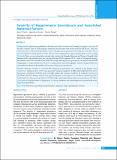Please use this identifier to cite or link to this item:
https://hdl.handle.net/20.500.14356/1401Full metadata record
| DC Field | Value | Language |
|---|---|---|
| dc.contributor.author | Thakur, Murari | - |
| dc.contributor.author | Gautam, Jageshwor | - |
| dc.contributor.author | Dangal, Ganesh | - |
| dc.date.accessioned | 2023-05-10T06:03:18Z | - |
| dc.date.available | 2023-05-10T06:03:18Z | - |
| dc.date.issued | 2019 | - |
| dc.identifier.citation | ThakurM., GautamJ., & DangalG. (2019). Severity of Hyperemesis Gravidarum and Associated Maternal factors. Journal of Nepal Health Research Council, 17(3), 293-296. https://doi.org/10.33314/jnhrc.v17i3.2113 | en_US |
| dc.identifier.issn | Print ISSN: 1727-5482; Online ISSN: 1999-6217 | - |
| dc.identifier.uri | http://103.69.126.140:8080/handle/20.500.14356/1401 | - |
| dc.description | Original Article | en_US |
| dc.description.abstract | Abstract Background: Hyperemesis gravidarum is the most severe form of nausea and vomiting in pregnancy. It is one of the most common cause of early pregnancy admissions and associated with various maternal risk factors . Very few studies have been conducted among Nepalese women with hyperemesis gravidarum. This study aims to identify various maternal risk factors among Nepalese women and its severity using pregnancy unique quantification of emesis scoring. Methods: This is a cross sectional observational study conducted at Paropakar Maternity and Women’s Hospital. Total duration of the study period was for one year from February 2018 to Janurary 2019. A total of 144 patients meeting the inclusion criteria were included in the study.The severity of the hyperemesis gravidarum was assessed and classified using pregnancy unique quantification of emesis scoring. Various maternal demographic, obstetric and personal factors were studied in relation to the incidence and severity of hyperemesis gravidarum. Results: Moderate (49.30%) to severe(50.69%) hyperemesis gravidarum were admitted in the hospital. Most women were nulliparous from 20-24 years age group. Among all categories of BMI, underweight had more severe hyperemesis gravidarum (63.63%) and overweight patient had increased incidence of moderate hyperemesis gravidarum (66.66%). Women with previous dysmenorrhea had severe hyperemesis gravidarum (54.05%) and non-smoker had severe hyperemesis gravidarum (52.03%) while smoker had moderate hyperemesis gravidarum (57.14%). Conclusions: Pregnant women of age group of 20-24 years, nulliparity and underweight were associated with severe hyperemesis gravidarum. Keywords: Hyperemesis gravidarum; maternal factors ; pregnancy unique quantification of emesis. | en_US |
| dc.language.iso | en | en_US |
| dc.publisher | Nepal Health Research Council | en_US |
| dc.relation.ispartofseries | July-Sep, 2019;2113 | - |
| dc.subject | Hyperemesis gravidarum | en_US |
| dc.subject | Maternal factors | en_US |
| dc.subject | Pregnancy unique quantification of emesis | en_US |
| dc.title | Severity of Hyperemesis Gravidarum and Associated Maternal factors | en_US |
| dc.type | Journal Article | en_US |
| local.journal.category | Original Article | - |
| Appears in Collections: | Vol. 17 No. 3 Issue 44 Jul-Sep 2019 | |
Files in This Item:
| File | Description | Size | Format | |
|---|---|---|---|---|
| 2113-Manuscript-12198-1-10-20191114.pdf | Fulltext Download | 212.02 kB | Adobe PDF |  View/Open |
Items in DSpace are protected by copyright, with all rights reserved, unless otherwise indicated.
